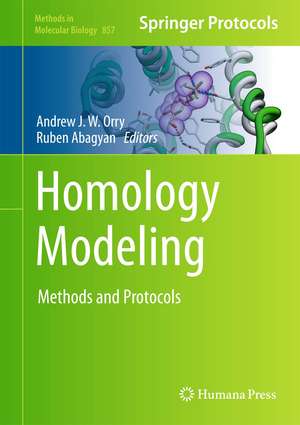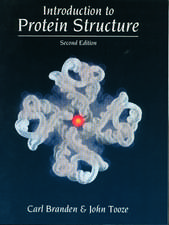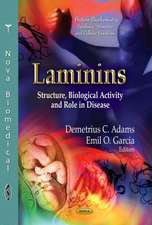Homology Modeling: Methods and Protocols: Methods in Molecular Biology, cartea 857
Editat de Andrew J. W. Orry, Ruben Abagyanen Limba Engleză Hardback – 10 feb 2012
Thorough and intuitive, Homology Modelling: Methods and Protocols guides scientists in the available homology modeling methods.
| Toate formatele și edițiile | Preț | Express |
|---|---|---|
| Paperback (1) | 708.61 lei 6-8 săpt. | |
| Humana Press Inc. – 23 aug 2016 | 708.61 lei 6-8 săpt. | |
| Hardback (1) | 963.29 lei 6-8 săpt. | |
| Humana Press Inc. – 10 feb 2012 | 963.29 lei 6-8 săpt. |
Din seria Methods in Molecular Biology
- 9%
 Preț: 791.63 lei
Preț: 791.63 lei - 23%
 Preț: 598.58 lei
Preț: 598.58 lei - 20%
 Preț: 882.98 lei
Preț: 882.98 lei -
 Preț: 252.05 lei
Preț: 252.05 lei - 5%
 Preț: 802.70 lei
Preț: 802.70 lei - 5%
 Preț: 729.61 lei
Preț: 729.61 lei - 5%
 Preț: 731.43 lei
Preț: 731.43 lei - 5%
 Preț: 741.30 lei
Preț: 741.30 lei - 5%
 Preț: 747.16 lei
Preț: 747.16 lei - 15%
 Preț: 663.45 lei
Preț: 663.45 lei - 18%
 Preț: 1025.34 lei
Preț: 1025.34 lei - 5%
 Preț: 734.57 lei
Preț: 734.57 lei - 18%
 Preț: 914.20 lei
Preț: 914.20 lei - 15%
 Preț: 664.61 lei
Preț: 664.61 lei - 15%
 Preț: 654.12 lei
Preț: 654.12 lei - 18%
 Preț: 1414.74 lei
Preț: 1414.74 lei - 5%
 Preț: 742.60 lei
Preț: 742.60 lei - 20%
 Preț: 821.65 lei
Preț: 821.65 lei - 18%
 Preț: 972.30 lei
Preț: 972.30 lei - 15%
 Preț: 660.49 lei
Preț: 660.49 lei - 5%
 Preț: 738.41 lei
Preț: 738.41 lei - 18%
 Preț: 984.92 lei
Preț: 984.92 lei - 5%
 Preț: 733.29 lei
Preț: 733.29 lei -
 Preț: 392.60 lei
Preț: 392.60 lei - 5%
 Preț: 746.26 lei
Preț: 746.26 lei - 18%
 Preț: 962.66 lei
Preț: 962.66 lei - 23%
 Preț: 860.22 lei
Preț: 860.22 lei - 15%
 Preț: 652.64 lei
Preț: 652.64 lei - 5%
 Preț: 1055.50 lei
Preț: 1055.50 lei - 23%
 Preț: 883.87 lei
Preț: 883.87 lei - 19%
 Preț: 491.89 lei
Preț: 491.89 lei - 5%
 Preț: 1038.86 lei
Preț: 1038.86 lei - 5%
 Preț: 524.16 lei
Preț: 524.16 lei - 18%
 Preț: 2122.34 lei
Preț: 2122.34 lei - 5%
 Preț: 1299.23 lei
Preț: 1299.23 lei - 5%
 Preț: 1339.12 lei
Preț: 1339.12 lei - 18%
 Preț: 1390.26 lei
Preț: 1390.26 lei - 18%
 Preț: 1395.63 lei
Preț: 1395.63 lei - 18%
 Preț: 1129.65 lei
Preț: 1129.65 lei - 18%
 Preț: 1408.26 lei
Preț: 1408.26 lei - 18%
 Preț: 1124.92 lei
Preț: 1124.92 lei - 18%
 Preț: 966.27 lei
Preț: 966.27 lei - 5%
 Preț: 1299.99 lei
Preț: 1299.99 lei - 5%
 Preț: 1108.51 lei
Preț: 1108.51 lei - 5%
 Preț: 983.76 lei
Preț: 983.76 lei - 5%
 Preț: 728.16 lei
Preț: 728.16 lei - 18%
 Preț: 1118.62 lei
Preț: 1118.62 lei - 18%
 Preț: 955.25 lei
Preț: 955.25 lei - 5%
 Preț: 1035.62 lei
Preț: 1035.62 lei - 18%
 Preț: 1400.35 lei
Preț: 1400.35 lei
Preț: 963.29 lei
Preț vechi: 1174.74 lei
-18% Nou
Puncte Express: 1445
Preț estimativ în valută:
184.38€ • 200.35$ • 154.98£
184.38€ • 200.35$ • 154.98£
Carte tipărită la comandă
Livrare economică 21 aprilie-05 mai
Preluare comenzi: 021 569.72.76
Specificații
ISBN-13: 9781617795879
ISBN-10: 1617795879
Pagini: 395
Ilustrații: XI, 419 p. 89 illus., 55 illus. in color.
Dimensiuni: 178 x 254 x 30 mm
Greutate: 0.96 kg
Ediția:2012
Editura: Humana Press Inc.
Colecția Humana
Seria Methods in Molecular Biology
Locul publicării:Totowa, NJ, United States
ISBN-10: 1617795879
Pagini: 395
Ilustrații: XI, 419 p. 89 illus., 55 illus. in color.
Dimensiuni: 178 x 254 x 30 mm
Greutate: 0.96 kg
Ediția:2012
Editura: Humana Press Inc.
Colecția Humana
Seria Methods in Molecular Biology
Locul publicării:Totowa, NJ, United States
Public țintă
Professional/practitionerCuprins
Classification of Proteins: Available Structural Space for MolecularModelling.-Effective Techniques for Protein Structure Mining.-Methods for Sequence-structure Alignment.-Force Fields for Homology Modeling.-Automated Protein Structure Modeling with SWISS-MODEL Workspace and the Protein Model Portal.-A Practical Introduction to Molecular Dynamics Simulations: Applications to Homology Modeling.-Methods for Accurate Homology Modeling by Global Optimization.-Ligand-Guided Receptor Optimization.-Loop Simulations.-Methods of Protein Structure Comparison.- Homology Modeling of Class A G Protein-Coupled Receptors.-Homology Modeling of Transporter Proteins (Carriers and Ion Channels).-Methods for the Homology Modeling of Antibody Variable Regions.-Investigating Protein Variants using Structural Calculation Techniques.-Macromolecular Assembly Structures by Comparative Modeling and Electron Microscopy.-Preparation and Refinement of Model Protein-Ligand Complexes.-Modeling Peptide-protein Interactions.-Comparison of Common Homology Modeling Algorithms: Application of User-defined Alignments.
Textul de pe ultima copertă
Knowledge about protein tertiary structure can guide experiments, assist in the understanding of structure-function relationships, and aid the design of new therapeutics for disease. Homology modeling is an in silico method that predicts the tertiary structure of an amino acid sequence based on a homologous experimentally determined structure. In, Homology Modeling: Methods and Protocols experts in the field describe each homology modeling step from first principles, provide case studies for challenging modeling targets and describe methods for the prediction of how other molecules such as drugs can interact with the protein. Written in the highly successful Methods in Molecular Biology™ series format, the chapters include the kind of detailed description and implementation advice that is crucial for getting optimal results in the laboratory.
Thorough and intuitive, Homology Modeling: Methods and Protocols guides scientists in the available homology modeling methods.
.
Thorough and intuitive, Homology Modeling: Methods and Protocols guides scientists in the available homology modeling methods.
.
Caracteristici
Describes homology modeling steps from first principles Provides step-by-step detail essential for reproducible results Contains key notes and implementation advice from the experts Includes supplementary material: sn.pub/extras













